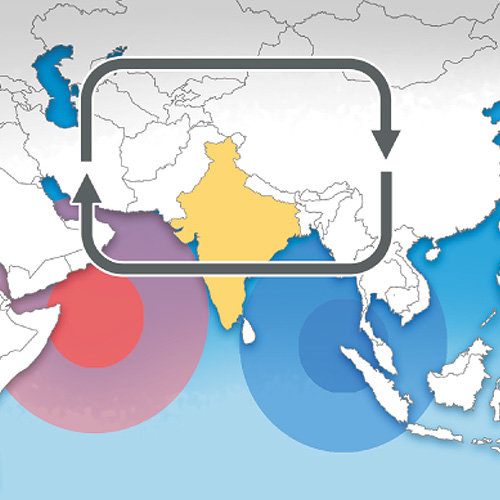‘Wingbeat in ocean’ generates disasters
‘Wingbeat in ocean’ generates disasters
Posted May. 23, 2020 08:03,
Updated May. 23, 2020 08:03

There is a saying that a butterfly’s wing stroke in Beijing causes a storm in New York the next month. It means the flapping of the wings by a small butterfly can amass strong impact to cause a storm on the other side of the globe, which is dubbed “butterfly theory.” A phenomenon that has nothing to do with humans has brought about disasters across the world from late last year to this spring because of the abnormal rise of seawater temperatures.
The phenomenon is called “dipole” wherein the sea surface in the east of the Indian Ocean is cool while that in the west of the ocean is warm. “Dipole” used to occur every 16 years, but the gap in the sea surface temperatures between the two locations increased significantly to an extreme level of as much as 2 degrees Celsius late last year.
A dipole in the Indian Ocean makes the ocean’s east side, East Africa, Oman, and Yemen area into low atmospheric pressure belts. It brought about downpours in the region while flash floods left hundreds of thousands of homeless. Along with heavy rainfall, a massive number of desert locusts started breeding. Large flocks of locusts, which bred in southern Yemen and Oman, moved to East Africa, Pakistan and India, and they caused astronomically heavy damage. As much as 5.55 million hectares of farmland became devastated in India, causing economic damage worth about 137 million U.S. dollars, while 1.05 million hectares of farmland became wasteland in Kenya.
High sea surface temperatures stemming from the dipole in the Indian Ocean caused abnormally high temperatures and heat waves in Europe, and the high temperatures shifted into China and Korea along the westerlies. For this reason, Korea saw unusually warm weather from December last year to February this year. Also, the dipole in the Indian Ocean activated Indian Monsoon, causing downpour and snow in Pakistan, northern India, and the Himalayas. These regions, which generally do not get any rain and snow during winter, had rain and snow this year, two to 80 times more than the average in ordinary years. Four Korean teachers who were hiking Mount Annapurna went missing in a tragic accident caused by avalanche. They visited the mountain during the season when avalanche is minimal, but avalanche occurred due to heavy snow stemming from the surface dipole in the Indian Ocean, and left the teachers killed tragically.
The dipole in the Indian Ocean fueled the worst wildfires in Australia. The dipole generated low atmospheric pressure belts to the east of the Indian Ocean, while occurring high atmospheric belts in Australia. As high atmospheric pressure belts were created in Australia, the country concurrently faced heat wave and drought. Wildfires in Australia started in September last year when temperatures in Canberra soared to hit 49 degrees Celsius, and continued to wreck havoc through early this year. In New South Wales alone where damage from the wildfires were minimal compared with other regions, more than 4 million hectares of forest land were reduced to ashes, and more than 1 billion wild animals including wallabies were killed.
Rising temperatures in sea surface of the ocean, which causes meteorological disasters, make people fear that robust El Niño in the ocean will bring about serious natural disasters. It is because higher sea surface temperatures would occur more grave El Niño.




![탈성매매女 “이달 지원금 540만원으로 줄어” 불만글 시끌 [e글e글]](https://dimg.donga.com/c/138/175/90/1/wps/NEWS/IMAGE/2025/12/26/133040473.3.jpg)


